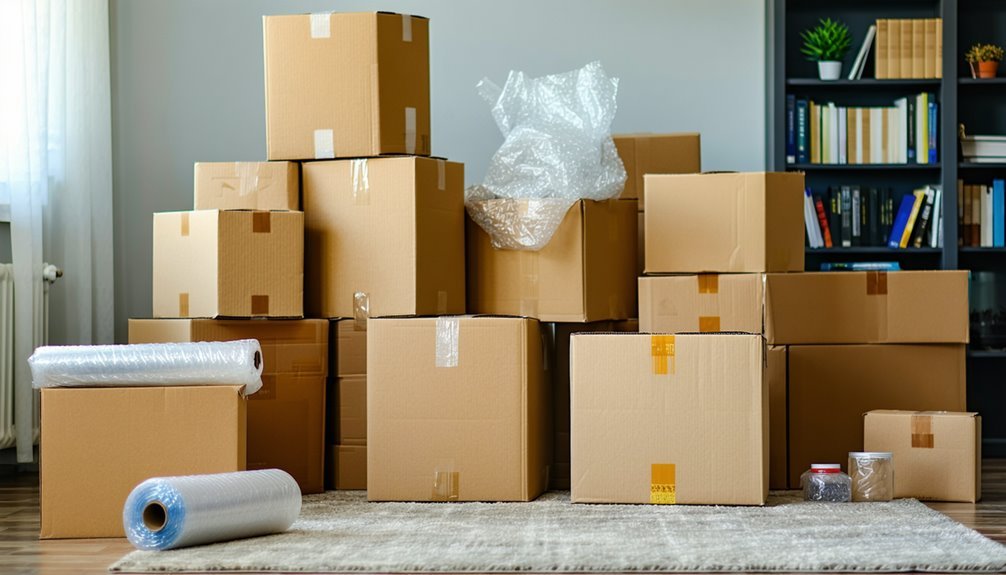Moving day can be intimidating, but with the right preparation, you'll navigate it with ease. Start by decluttering your space. You don't need to pack items you haven't used in a year. Next, secure enough packing supplies—boxes, tape, and bubble wrap. It's also essential to label each box by room and contents; this step will save you a headache later. Now, think about your first night in the new home. What will you need immediately? Packing an essentials box is a game-changer. Wondering what should go in there or how to streamline the rest of the process? Let's explore further.
Key Takeaways
- Start preparations early by creating a detailed moving timeline and securing packing supplies.
- Book a reliable moving company and notify utilities and service providers two weeks in advance.
- Pack an essentials box including toiletries, important documents, and a change of clothes.
- Label all boxes clearly with contents and intended room placement for efficient unpacking.
- Conduct a final home walkthrough to ensure all items are packed and secure the property before departure.
Early Planning and Organization
Starting your move with plenty of time to spare is essential. Early planning allows you to create a detailed timeline, noting all key dates leading up to moving day. This timeline should include when to start decluttering, purchase packing supplies, and finalize arrangements with your chosen moving company.
By setting these milestones, you guarantee nothing is left until the last minute, paving the way for a stress-free experience.
Organization is your best friend during a move. Begin by decluttering your current home. Sort items into categories: keep, donate, sell, and discard. This not only simplifies packing but also reduces the volume of goods you're moving, potentially lowering moving costs.
Next, allocate a moving budget. Consider all expenses, from packing supplies to moving company fees. This financial planning prevents unexpected costs from sneaking up on you.
Lastly, book a reliable moving company early. Researching and securing a mover two months in advance gives you the advantage of better rates and availability. Confirm you review their credentials thoroughly to avoid last-minute disappointments.
Managing Utilities and Services
Once you're two weeks away from moving day, it's important to handle your utilities and services to guarantee a smooth switch.
Start by contacting your utility providers—electricity, gas, water, and internet—to schedule service shutdowns at your current home and set up installations at your new address. This guarantees you won't face any interruptions once you've moved.
Next, update your service providers with your new address for any final bills. It's important to set up mail forwarding through USPS to keep receiving important correspondence without a hitch.
This step prevents missing out on important notifications or bills during the switch period.
Don't forget to arrange for trash and recycling pickup at your new home. Having these services ready right from the start will help you manage waste efficiently and avoid any unnecessary stress during your settling-in phase.
Lastly, notify your insurance company about your move. Whether it's homeowners or renters insurance, updating your policy with your new location details is fundamental for maintaining your coverage without any gaps.
Essentials for Moving Day

To guarantee a smooth changeover into your new home, pack an essentials box with toiletries, snacks, important documents, and a change of clothes. This box guarantees you've got the basics covered from the moment you step into your new space.
It's vital to have easy access to these items, so you aren't rummaging through boxes when you should be settling in.
Additionally, keep your movers fueled and ready by preparing healthy snacks and refreshments. This keeps everyone's energy up and makes the moving process smoother and more efficient.
Also, organizing a checklist of must-have items like chargers, medications, and basic kitchen supplies guarantees you won't be left without necessities during the first hours in your new home.
Confirm all your boxes are clearly labeled. This not only helps you but also aids the movers in placing boxes in the correct rooms, speeding up the unpacking process.
Confirm that utilities are working in your new home before the move, so you're not caught off-guard by a cold shower or a dark living room.
With these steps, you'll be ready to enjoy your new home from day one.
Final Home and Key Checks
After confirming your essentials are packed and ready, shift your focus to the final checks in your old home. This is an essential step to guarantee you leave everything in order and secure before moving day.
Follow these key pointers during your final walk-through:
- Check each room: Don't overlook less-frequented areas like attics or basements. Open every cabinet, peek into all closets, and verify nothing is left behind.
- Inspect the moving truck: Before the truck pulls away, check that all your possessions are accounted for and securely loaded. This minimizes the risk of leaving anything significant behind.
- Address damages: Note any damages to furniture or boxes. This is important for any potential insurance claims with the moving company.
- Secure the home: Make certain all windows are closed, lights turned off, and doors locked. Activate the security system if you have one.
Settling Into the New Home

Arriving at your new home marks the beginning of an exciting chapter in your life. The first step in settling in is to set up essential areas—kitchen, bathroom, and bedrooms. This guarantees you're comfortable from day one.
It's vital to perform an inventory check to verify all your belongings arrived undamaged. If you spot any discrepancies, address them with the moving company right away to avoid complications later.
Next, focus on unpacking strategically. Start with the rooms you use most, allowing you to live normally while you sort through and possibly discard unnecessary items. This approach not only clears space but also helps you mentally settle into your new home.
Don't forget to change the locks for safety. You can't be too sure who else has keys to your new place. Consider adding a security system to further enhance your family's safety.
Lastly, take some time to explore local amenities. A quick walk or drive around your neighborhood can uncover parks, cafes, and perhaps your new favorite grocery store.
Connecting with these conveniences can transform your new house into a home, making your shift smoother and more enjoyable.
Post-Move Adjustments
Once you've settled into your new home, it's time to focus on post-move adjustments to confirm everything runs smoothly. These steps will help you shift into your new environment with ease and comfort.
- Unpack Essential Items: Start by unpacking essential items like kitchen supplies and toiletries. Having these accessible will make your new home functional and comfortable immediately.
- Maintenance Checks: Schedule maintenance checks for utilities and appliances within the first few weeks. This guarantees all systems are operational and any issues are addressed promptly.
- Familiarize with Local Resources: Get to know your local resources. Identify nearby grocery stores, healthcare providers, and other essential services. This knowledge will support your daily needs and help you feel more at home.
- Engage with the Community: Introduce yourself to neighbors and participate in local events. Building connections within your community can foster a sense of belonging and provide valuable support.
In addition to these steps, take time to assess and organize your living space.
Making adjustments for organization can greatly enhance your comfort and the efficiency of your new home.
These post-move adjustments are key to settling in and starting your new chapter on the right foot.
Additional Moving Resources

Now that you're settling into your new home, you might find yourself needing additional resources to streamline the final stages of your move. Online platforms like Moving.com offer thorough moving checklists and packing tips, helping you stay organized and ensuring nothing gets overlooked. They also provide cost estimators to help you budget effectively.
Don't forget the usefulness of mobile apps such as Sortly or Moving Planner, which allow you to create a digital inventory of your belongings. This can be essential for keeping track of your items during the move and ensuring everything arrives safely.
If you're short on help, platforms like TaskRabbit or Thumbtack can connect you with local movers. These services can assist with everything from packing to loading, making your moving day far less stressful.
Also, tap into local resources through Nextdoor or Facebook Marketplace for recommendations on moving services near you.
For those interested in eco-friendly moving, look into companies that offer reusable supplies or facilitate donations of unwanted items. This approach not only helps the environment but also supports your new community by contributing to local charities.
Frequently Asked Questions
How Long Before Moving Day Should I Start Packing?
You should start packing non-essential items about 4 to 6 weeks before your move.
Use a packing timeline to organize tasks and gather moving supplies early. This early start allows time for decluttering and applying efficient packing techniques.
Pack essential items last, about a week prior, ensuring they're accessible.
Follow these steps to manage stress and streamline your process, setting up an unpacking strategy that mirrors your organized approach.
What Do You Need for Moving Day?
For moving day, you'll need a well-thought-out moving supplies checklist.
Make sure you've got all packing materials, essential tools, and furniture protection. Don't forget moving day snacks and water to keep everyone energized.
Review your transport options and finalize organization strategies. If moving with pets, double-check their arrangements.
Prioritize last-minute tasks and follow unloading tips to streamline the process.
This preparation makes certain you tackle the day with confidence, minimizing stress and confusion.
How Do You Pack for a Move in Day?
When packing for your move, start early with a clear packing timeline. Gather essential supplies and durable packing materials to protect fragile items.
Use a room organization strategy, packing non-essentials first and labeling boxes clearly. Keep an inventory checklist handy to track everything.
Avoid heavy lifting injuries by packing lighter items in big boxes. Remember last-minute tips like packing an essentials box for easy access upon arrival.
This approach guarantees a smooth changeover.
How Should a Customer Prepare for Moving Day?
To prepare for moving day, start by finalizing your moving checklist, including utility transfers and address changes.
Verify you've got enough packing supplies and use efficient packing techniques.
Manage stress by reviewing moving logistics and confirming details with hired movers.
Stick to your moving budget, but plan for unexpected costs.
Prioritize essential items for easy access and double-check everything before the movers arrive to make the relocation process smoother. This preparation will save you time and reduce stress on moving day, ensuring everything is organized and accounted for. Labeling boxes clearly and keeping important documents or valuables with you can also go a long way in avoiding common moving mistakes. By staying proactive and methodical, you’ll set yourself up for a seamless transition to your new home.
Conclusion
Now that you've tackled the checklist, you're set for a smoother move. Don't forget to double-check everything, from utility setups to the essentials box. Start unpacking as soon as you can to feel at home quicker. Adjusting might take a bit, but you've got this! For any bumps along the way, refer back to your moving resources. Remember, it's not just about moving stuff—it's about starting fresh. Welcome to your new beginning!


